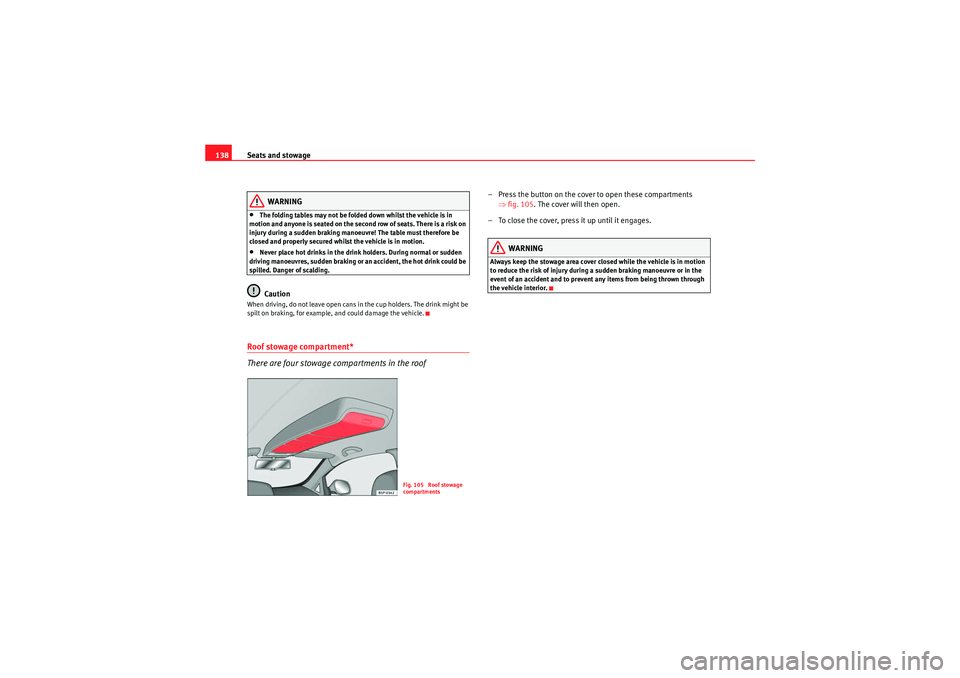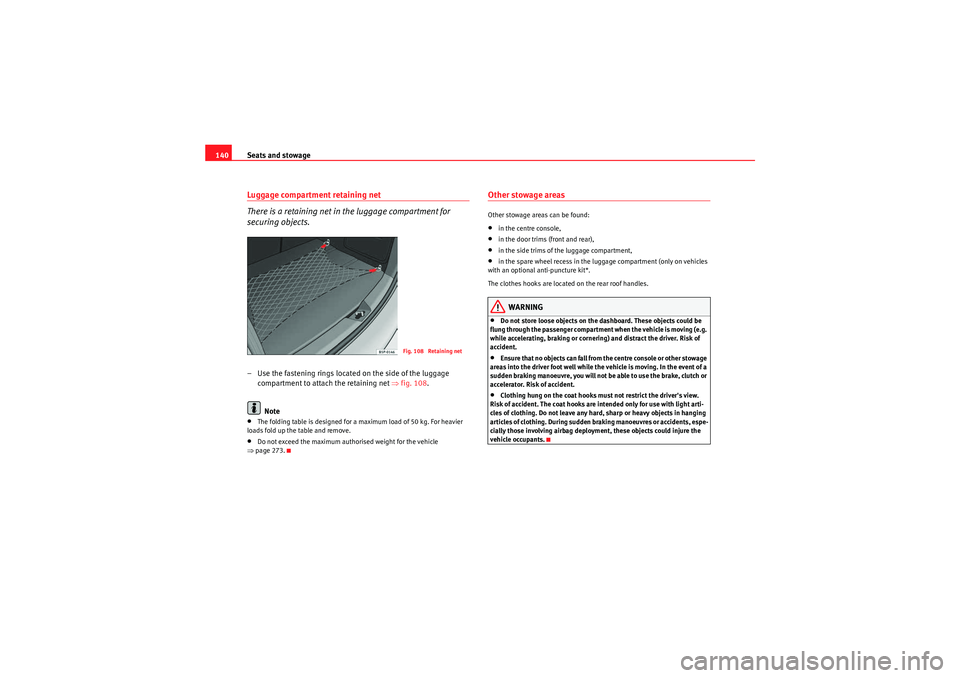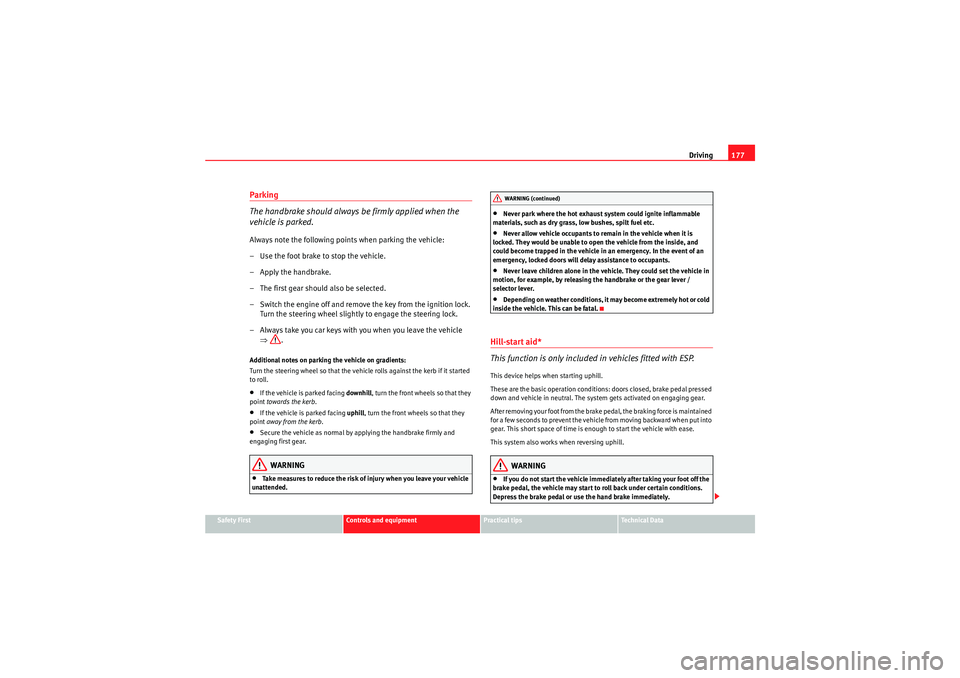ECU Seat Altea Freetrack 2010 Owner's Guide
[x] Cancel search | Manufacturer: SEAT, Model Year: 2010, Model line: Altea Freetrack, Model: Seat Altea Freetrack 2010Pages: 294, PDF Size: 7.71 MB
Page 105 of 294

Unlocking and locking103
Safety First
Controls and equipment
Practical tips
Technical Data
Activation
– It is automatically turned on with the anti-theft alarm, when the
vehicle is locked mechanically with the key and when the button
on the remote control is used.
Deactivation
– Press the button on the remote control twice. Only the volu- metric sensor is deactivated. The alarm system remains acti-
vated.
WARNING
•The “safe” security system remains deactivated if the volumetric
sensor is deactivated.•For those vehicles in which a separate sunblind is fitted in the
passenger compartment, the alarm will not function correctly due to inter-
ference with the sensor.Note
•If the alarm has been triggered by the volumetric sensor, this will be indi-
cated by a flashing of the indicator on the driver's door. This flashing will be
different to that for an activated alarm.
Freetrack_EN.book Seite 103 Donnerstag, 10. September 2009 10:33 10
Page 133 of 294

Seats and stowage131
Safety First
Controls and equipment
Practical tips
Technical Data
Removing or adjusting head restraints
The head restraints can be adjusted by moving them up and
down.Adjusting height (front seats)
– Press the button on the side and pull upwards to the desired
position.
– To lower the head restraint, press the button and push head
restraint downwards.
– Make sure that it engages securely into position.
Adjusting height (rear seats)
– Press the button on the side and pull upwards to the desired position. – To lower the head restraint,
press the button and push head
restraint downwards.
– Make sure that the head restraint engages securely in one of its positions ⇒page 14.
Angle adjustment (front seats)
– Press the head restraint forward or back to the required position.
Removing the head restraint
– Push the head restraint up as far as it will go.
– Press the button ⇒fig. 93 (arrow).
– Pull head restraint out of fitting without releasing the button.
Fitting the head restraint
– Insert the head restraint into the guides on the rear backrest.
– Push head restraint down.
– Adjust the head restraint to suit body size ⇒page 14 and
⇒ page 13.
WARNING
•Never drive if the head restraints have been removed. Risk of injury.•Never drive if the head restraints are in an unsuitable position, there is
a risk of serious injury.•After refitting the head restraint, you must always adjust it properly for
height to achieve optimal protection.•Please observe the safety warnings ⇒page 130, “Correct adjustment
of head restraints”.
Fig. 93 Adjusting and
removing the head
restraints
Freetrack_EN.book Seite 131 Donnerstag, 10. September 2009 10:33 10
Page 134 of 294

Seats and stowage
132 Front seatsAdjustment of the front seatsThe control elements in ⇒fig. 94 are mirrored for the front right-
hand seat.
Adjusting the seat forwards and backwards
– Pull up the grip and move the seat forwards or backwards.
– Then release the grip and move the seat further until the catch engages.
Adjusting the seat height*
– Pull the lever up or push down (several times if necessary) from its home position. This adjust s the seat height in stages. Adjusting the backrest angle
– Take your weight off the backrest and turn the hand wheel.
Adjusting the lumbar support*
– Take your weight off the backrest and turn the hand wheel to adjust the lumbar support.
The backrest curvature of the cushioned area is determined by the settings
made in the lumbar region. This supports the natural curvature of the spine
very effectively.
WARNING
•Never adjust the driver or front passenger seat while the vehicle is in
motion. While adjusting your seat, you will assume an incorrect sitting
position. Risk of fatal accidents. Adjust the driver or front passenger seat
only when the vehicle is stationary.•To reduce the risk of injury to the driver and front passenger in case of
a sudden braking or an accident, never drive with the backrest tilted
towards the rear. The maximum protection of the seat belt can be achieved
only when the backrests are in an upright position and the driver and front
passenger have properly adjusted their seat belts. The further the back-
rests are tilted to the rear, the greater the risk of injury due to improper
positioning of the belt web!•Exercise caution when securing the seat height into forwards/back-
wards position. Injuries can be caused if the seat height is adjusted
without due care and attention.
Fig. 94 Front left seat
controls
A1
A1
A2
A3A4
Freetrack_EN.book Seite 132 Donnerstag, 10. September 2009 10:33 10
Page 137 of 294

Seats and stowage135
Safety First
Controls and equipment
Practical tips
Technical Data
Folding the seat backrests down – Pull the loop on the side of the seat ⇒fig. 99 I n t h is p o si t i o n t h e b a ck r e s t is l o cke d . T h i s is t h e r ea s o n w h y t h e l o o p l o ca t e d
o n the si d e of the sea t m us t be pulled in th e d ire ct io n of t he a r row to op e n t he
backrest.
WARNING
•You should check that the backrest has engaged properly in position
after the loop is released.•The locking system loops on the seats may not, for reasons of safety, be
used to secure any items.
Folding the rear seat backrests down– Pull the loop on the side of the seat ⇒fig. 100 in the direc-
tion of the arrow and lift the seat backrest into position.
WARNING
•You should check that the backrest has engaged properly in position
after the loop is released.•The locking system loops on the seats may not, for reasons of safety, be
used to secure any items.•After locking the seat backrest into position ensure that the seat belts
protrude from the seat.
Fig. 99 Folding or
opening the rear seat
backrestsA1
Fig. 100 Folding or
opening the front seat
backrests
A1
Freetrack_EN.book Seite 135 Donnerstag, 10. September 2009 10:33 10
Page 140 of 294

Seats and stowage
138
WARNING
•The folding tables may not be folded down whilst the vehicle is in
motion and anyone is seated on the second row of seats. There is a risk on
injury during a sudden braking manoeuvre! The table must therefore be
closed and properly secured whilst the vehicle is in motion.•Never place hot drinks in the drink holders. During normal or sudden
driving manoeuvres, sudden braking or an accident, the hot drink could be
spilled. Danger of scalding.Caution
When driving, do not leave open cans in the cup holders. The drink might be
spilt on braking, for example, and could damage the vehicle.Roof stowage compartment*
There are four stowage compartments in the roof
– Press the button on the cover to open these compartments ⇒fig. 105 . The cover will then open.
– To close the cover, press it up until it engages.
WARNING
Always keep the stowage area cover closed while the vehicle is in motion
to reduce the risk of injury during a sudden braking manoeuvre or in the
event of an accident and to prevent any items from being thrown through
the vehicle interior.
Fig. 105 Roof stowage
compartments
Freetrack_EN.book Seite 138 Donnerstag, 10. September 2009 10:33 10
Page 141 of 294

Seats and stowage139
Safety First
Controls and equipment
Practical tips
Technical Data
Stowage in the luggage compartment*
There is a variable stowage area* in the luggage compart-
ment floor.
– Lift the luggage compartment floor and fold it back all the way
⇒fig. 106 .
– Fit the separator ⇒fig. 107 , into the side grooves depending
on the size of the objects to be transported. The onboard tool kit
and the spare wheel are located underneath the luggage
compartment.
– Secure luggage in the luggage compartment with suitable straps on the fastening rings.
Note•The folding table is designed for a maximum load of 50 kg. For heavier
loads fold up the table and remove.•Do not exceed the maximum authorised weight for the vehicle
⇒ page 273.
Fig. 106 Variable floor
boot stowage compart-
mentFig. 107 Variable floor
boot stowage compart-
ment
AA
Freetrack_EN.book Seite 139 Donnerstag, 10. September 2009 10:33 10
Page 142 of 294

Seats and stowage
140Luggage compartment retaining net
There is a retaining net in the luggage compartment for
securing objects.– Use the fastening rings located on the side of the luggage
compartment to attach the retaining net ⇒ fig. 108.
Note•The folding table is designed for a maximum load of 50 kg. For heavier
loads fold up the table and remove.•Do not exceed the maximum authorised weight for the vehicle
⇒ page 273.
Other stowage areasOther stowage areas can be found:•in the centre console,•in the door trims (front and rear),•in the side trims of the luggage compartment,•in the spare wheel recess in the luggage compartment (only on vehicles
with an optional anti-puncture kit*.
The clothes hooks are located on the rear roof handles.WARNING
•Do not store loose objects on the dashboard. These objects could be
flung through the passenger compartment when the vehicle is moving (e.g.
while accelerating, braking or cornering) and distract the driver. Risk of
accident.•Ensure that no objects can fall from the centre console or other stowage
areas into the driver foot well while the vehicle is moving. In the event of a
sudden braking manoeuvre, you will not be able to use the brake, clutch or
accelerator. Risk of accident.•Clothing hung on the coat hooks must not restrict the driver's view.
Risk of accident. The coat hooks are intended only for use with light arti-
cles of clothing. Do not leave any hard, sharp or heavy objects in hanging
articles of clothing. During sudden br aking manoeuvres or accidents, espe-
cially those involving airbag deployment, these objects could injure the
vehicle occupants.
Fig. 108 Retaining net
Freetrack_EN.book Seite 140 Donnerstag, 10. September 2009 10:33 10
Page 144 of 294

Seats and stowage
142
Opening and closing the armrest*/ drink holder*
– To open, pull the loop in the direction of the arrow ⇒page 141,
fig. 110 .
– To close, lift the Drink holder*/ armrest* in the direction of the arrow ⇒page 141, fig. 111 .
WARNING
Ensure that the load in the luggage compartment is correctly secured with
the retainer net when travelling with the armrest down ⇒page 140.Multi-purpose* mobile stowage compartment - Fitting and removal
This stowage compartment may only be placed in the central
area of the rear seat
Fitting mobile stowage compartment
– Fold down the small section of the rear seat back rest, in order to
access the large section of the back rest.
– Fit the mobile stowage compartment mounting plate ⇒fig. 113 from the inside of the vehicle, through the rear section
of the seat. It should be fitted between the back rest and the
seat, in the central seat area.
– Push the plate until it clips the cushion frame. The rings of the mobile stowage compartment mounting plate appear at the front
of the seat.
– If it is difficult to make the plate clip, tilt the rear back rest of the large section forwards slightly an d then lean the back rest back-
wards to make the fitting of the mobile stowage compartment
onto the mounting plate easier.
A1
A2
Fig. 112 Mobile stowage
compartment Installation
Fig. 113 Mobile stowage
compartment mounting
plate
AH
Freetrack_EN.book Seite 142 Donnerstag, 10. September 2009 10:33 10
Page 151 of 294

Seats and stowage149
Safety First
Controls and equipment
Practical tips
Technical Data
BootStowing luggage
All luggage must be securely stowed.Please observe the following points to ensure the vehicle handles
well at all times:
– Distribute the load as evenly as possible.
– Place heavy objects as far forward in the luggage compartment
as possible.
– Secure luggage in the luggage compartment with suitable straps on the fastening rings*.
WARNING
•Loose luggage and other loose items in the vehicle can cause serious
injuries.•Loose objects in the luggage compartment can suddenly move and
change the way the vehicle handles.•During sudden manoeuvres or accidents, loose objects in the
passenger compartment can be flung forward, injuring vehicle occupants.•Always store objects in the luggage compartment and secure with suit-
able straps. This is especially important for heavy objects.•When you transport heavy objects, always take in account that a
change in the centre of gravity can also cause changes in vehicle handling.•Please observe information on safe driving ⇒page 7, “Safe driving”.
Caution
Hard objects on the shelf could chafe against the wires of the heating
element in the rear window and cause damage.
Note
The ventilation slots in front of the rear side windows must not be covered as
this would prevent stale air being extracted from the vehicle.
Freetrack_EN.book Seite 149 Donnerstag, 10. September 2009 10:33 10
Page 179 of 294

Driving177
Safety First
Controls and equipment
Practical tips
Technical Data
Parking
The handbrake should always be firmly applied when the
vehicle is parked.Always note the following points when parking the vehicle:
– Use the foot brake to stop the vehicle.
– Apply the handbrake.
– The first gear should also be selected.
– Switch the engine off and remove the key from the ignition lock.
Turn the steering wheel slightly to engage the steering lock.
– Always take you car keys with you when you leave the vehicle ⇒ .Additional notes on parking the vehicle on gradients:
Turn the steering wheel so that the vehicle rolls against the kerb if it started
to roll.•If the vehicle is parked facing downhill, turn the front wheels so that they
point towards the kerb .•If the vehicle is parked facing uphill, turn the front wheels so that they
point away from the kerb .•Secure the vehicle as normal by applying the handbrake firmly and
engaging first gear.WARNING
•Take measures to reduce the risk of injury when you leave your vehicle
unattended.
•Never park where the hot exhaust system could ignite inflammable
materials, such as dry grass, low bushes, spilt fuel etc.•Never allow vehicle occupants to remain in the vehicle when it is
locked. They would be unable to open the vehicle from the inside, and
could become trapped in the vehicle in an emergency. In the event of an
emergency, locked doors will delay assistance to occupants.•Never leave children alone in the vehicle. They could set the vehicle in
motion, for example, by releasing the handbrake or the gear lever /
selector lever.•Depending on weather conditions, it may become extremely hot or cold
inside the vehicle. This can be fatal.
Hill-start aid*
This function is only included in vehicles fitted with ESP.This device helps when starting uphill.
These are the basic operation conditions: doors closed, brake pedal pressed
down and vehicle in neutral. The system gets activated on engaging gear.
After removing your foot from the brake pedal, the braking force is maintained
for a few seconds to prevent the vehicle from moving backward when put into
gear. This short space of time is enough to start the vehicle with ease.
This system also works when reversing uphill.
WARNING
•If you do not start the vehicle immediately after taking your foot off the
brake pedal, the vehicle may start to roll back under certain conditions.
Depress the brake pedal or use the hand brake immediately.WARNING (continued)
Freetrack_EN.book Seite 177 Donnerstag, 10. September 2009 10:33 10